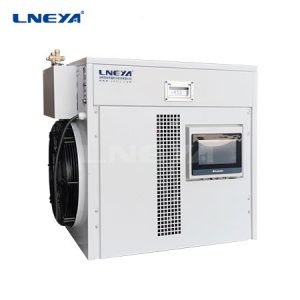Water Cooled Chiller System
What is water cooled chiller system?
A water cooled chiller system is a type of chiller that removes heat from it to cool water used in projects and industrial structures and re-enters the operating cycle. In effect, chillers move heat from a space that needs temperature control to another space. A chiller is therefore not a means of generating cold, but a means of dissipating heat, whose task is to facilitate the transfer of unwanted and unwanted heat caused by activity to a place outside the system.
Cooling towers are specially designed for water cooled chiller system. Because the condenser of the water cooled chiller system uses water as a stimulating and cooling material. The efficiency of the water cooled chiller system increases because the wetted surface is more successful at transferring heat and also doing work of compression at wetter temperatures.
How does water cooled chiller system work?
The water cooled chiller system comes into play during the evaporation process, the water and gas produced by the machine is taken to the evaporator and collects all the unwanted heat on the way, then returns to the evaporator and stores the heat energy obtained. After that, the refrigerant collects this heat and mobilizes it into the condensate, that is, the condenser sends all the collected heat to the cooling tower, and finally the hot air will pass through the cooling coil to dissipate the heat into the atmosphere.
The first stage:
The starting point of this cycle is where the water from the production process enters the evaporator to enter the cooling cycle.
During this part of the cycle, the heat absorbed by the refrigerant first occurs in the form of a phase change from liquid to gas. As the refrigerant absorbs heat from the water, the temperature of the environment in contact with this part drops, so the water leaves cooler. This water enters the fan coil and brings the cool air to the desired space.
In fact, the evaporator is a place where, in addition to the current one, it participates in another cycle, which is located between the evaporator and the water outlet of the cooling unit. In fact, hot water enters the chiller evaporator, where it is cooled and then pumped throughout the building to where it is needed.
second stage:
Gaseous refrigerant reaches the gas phase in a pre-liquid state before entering the compressor. In the compressor, the gas condenses, increasing the temperature and pressure so that the next high-pressure stage can be passed. The increase in pressure and temperature as it leaves the compressor is important because the refrigerant needs to release heat from inside the condenser, so it must carry enough heat to the condenser.
Another key function of the compressor is to draw refrigerant into the evaporator at the right time to keep the pressure inside the evaporator high enough to absorb heat again.
The third phase:
The hot gas enters the condenser where the gaseous refrigerant is converted to a saturated high pressure liquid. This is a constant pressure process.
Since the condenser exists in another cycle between the cooling towers, the water enters the cooling tower after it has increased in temperature. Because the main task of the cooling tower in the water cooled chiller system is to cool the consumed water while the condenser uses this water as its driving material.
Where the excess heat of the water is lost, the water temperature is restored to the desired low temperature. The heating process we mentioned earlier takes place in the condenser, releasing the gaseous refrigerant from the heat itself, which is the source of heat in question, which needs to be removed by a cooling tower. In this way, the water entering the cooling tower from the condenser contacts the air flow, transfers heat to the air, and then returns to the condenser.
The fourth stage:
The expansion valve is the last stage of the refrigerant, these processes take place with the refrigerant in the expansion valve causing the refrigerant to become a mixture of liquid and gas, the same compound re-enters the evaporator to resume the cycle, hot water re-enters from the other direction Evaporator.
The water cooled chiller system is used in hospitals, airports, manufacturing plants, industrial plants, shopping malls, etc., all of which are carried out under the premise of satisfying water. The problem with water cooled chiller systems is that they use a lot of water, are not suitable for use in water-scarce areas, and the water supply has its own cost.

低温チラー(水冷式・空冷式)
温度制御範囲:-150℃~-5
当社は、-150℃の温度制御範囲を持つ低温冷凍機の生産を専門としており、さまざまな業界の冷凍ニーズを満たすことができます。
| 温度範囲 | -25°C ~ -5°Cシリーズ | -45°C ~ -10°Cシリーズ | -60°C ~ -10°Cシリーズ | -80°C ~ -30°Cシリーズ | -110°C ~ -50°Cシリーズ |
| 冷却能力 | 最大360kW | 最大360kW | 最大360kW | 270kWまで | 180kWまで |

循環式チラー (水冷・空冷)
温度制御範囲:-120℃~+30
私達の再循環のスリラーは低温冷凍の技術を採用し、温度は- 120℃と低く、さまざまな付属品はカスタマイズ可能です。
| 温度範囲 | -25°C ~ +30°Cシリーズ | -45°C ~ +30°Cシリーズ | -60°C ~ -20°Cシリーズ | -80°C ~ -20°Cシリーズ | -120°C ~ -70°Cシリーズ |
| 冷却能力 | 最大38kW | 最大12kW | 最大7.2kW | 最大7.2kW | 最大8.6kW |

室温チラー/小型チラー
温度制御範囲+5℃〜+50
チラーは様々な産業や研究所で広く使用することができ、カスタマイズされた設計をサポートしています。
| 温度範囲 | -18°C ~ +30°C | +5°C ~ +35°Cシリーズ |
| 冷却能力 | 0.9kWまで | 最大50kW |

直接冷却式冷凍機
温度制御範囲:-120℃~-10
熱交換面積が小さく、熱交換が大きい場所に適している。
| 温度範囲 | -40°C ~ -10°C | -80°C ~ -35°C | -120°C ~ -90°C |
| コンプレッサーパワー | 8HPまで | 最大8HP*2 | 45HP*3まで |

直接冷却式超低温チラー
温度制御範囲:-150℃~-110
お客様のビジネスにカスタマイズされたソリューションを提供します。
| 温度範囲 | -150°C〜-110°C |
| 冷却能力 | 最大11kW |

スクリュー冷凍機
低温スクリュー冷凍機と常温スクリュー冷凍機
お客様のビジネスにカスタマイズされたソリューションを提供します。
| 温度範囲 | +5°C ~ +30°C | +5°C ~ +30°C | +5°C ~ +30°C | +5°C ~ +30°C | -25°C ~ +5°C | -25°C ~ +5°C |
| 冷却能力 | 最大1027kW(シングルコンプレッサー) | 最大2134kW(デュアルコンプレッサー) | 最大934kW(シングルコンプレッサー) | 最大1940kW(デュアルコンプレッサー) | 最大467kW(シングルコンプレッサー) | 最大497kW(シングルコンプレッサー) |
 LNEYA
LNEYA
 简体中文
简体中文

















































































